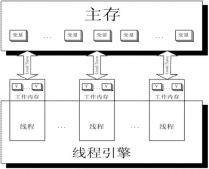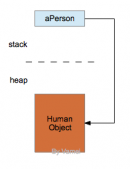join字面上是加入的意思,我们先看看join方法的解释和实现。
|
1
2
3
4
5
6
7
8
9
10
11
12
13
14
15
|
/** * Waits for this thread to die. * 调用方线程(调用join方法的线程)执行等待操作,直到被调用的线程(join方法所属的线程)结束,再被唤醒 * <p> An invocation of this method behaves in exactly the same * way as the invocation * * * @throws InterruptedException * if any thread has interrupted the current thread. The * <i>interrupted status</i> of the current thread is * cleared when this exception is thrown. */ public final void join() throws InterruptedException { join(0); } |
这里join是调用的
|
1
2
3
4
5
6
7
8
9
10
11
12
13
14
15
16
17
18
19
20
21
22
23
24
25
26
27
28
29
30
31
32
33
34
35
36
|
/** * Waits at most {@code millis} milliseconds for this thread to * die. A timeout of {@code 0} means to wait forever. * 等待线程执行结束,或者指定的最大等待时间到了,调用方线程再次被唤醒,如果最大等待时间为0,则只能等线程执行结束,才能被唤醒。 * <p> This implementation uses a loop of {@code this.wait} calls * conditioned on {@code this.isAlive}. As a thread terminates the * {@code this.notifyAll} method is invoked. It is recommended that * applications not use {@code wait}, {@code notify}, or * {@code notifyAll} on {@code Thread} instances. * * */ public final synchronized void join(long millis) throws InterruptedException { long base = System.currentTimeMillis(); long now = 0; if (millis < 0) { throw new IllegalArgumentException("timeout value is negative"); } if (millis == 0) { while (isAlive()) { wait(0); } } else { while (isAlive()) { long delay = millis - now; if (delay <= 0) { break; } wait(delay); now = System.currentTimeMillis() - base; } } } |
可以看到,join方法本身是通过wait方法来实现等待的,这里判断如果线程还在运行中的话,则继续等待,如果指定时间到了,或者线程运行完成了,则代码继续向下执行,调用线程就可以执行后面的逻辑了。
但是在这里没有看到哪里调用notify或者notifyAll方法,如果没有调用的话,那调用方线程会一直等待下去,那是哪里调用了唤醒它的方法呢?通过查证得知,原来在线程结束时,java虚拟机会执行该线程的本地exit方法,
|
1
2
3
4
5
6
7
8
9
10
11
12
13
14
15
16
17
18
19
20
21
22
23
24
|
//线程退出函数:void JavaThread::exit(bool destroy_vm, ExitType exit_type) {...//这里会处理join相关的销毁逻辑ensure_join(this);...}//处理join相关的销毁逻辑 static void ensure_join(JavaThread* thread) { Handle threadObj(thread, thread->threadObj()); ObjectLocker lock(threadObj, thread); thread->clear_pending_exception(); java_lang_Thread::set_thread_status(threadObj(), java_lang_Thread::TERMINATED); java_lang_Thread::set_thread(threadObj(), NULL); //这里就调用notifyAll方法,唤醒等待的线程 lock.notify_all(thread); thread->clear_pending_exception(); } |
这样线程什么时候被唤醒就明白了。下面写个例子看下效果。
|
1
2
3
4
5
6
7
8
9
10
11
12
13
14
15
16
17
18
19
20
21
22
23
24
25
26
27
28
29
30
31
32
33
34
35
36
37
38
39
40
41
42
43
44
45
46
47
|
public class JoinTest { public static void main(String[] args) { ThreadBoy boy = new ThreadBoy(); boy.start(); } static class ThreadBoy extends Thread{ @Override public void run() { System.out.println("男孩和女孩准备出去逛街"); ThreadGirl girl = new ThreadGirl(); girl.start(); try { girl.join(); } catch (InterruptedException e) { e.printStackTrace(); } System.out.println("男孩和女孩开始去逛街了"); } } static class ThreadGirl extends Thread{ @Override public void run() { int time = 5000; System.out.println("女孩开始化妆,男孩在等待。。。"); try { Thread.sleep(time); } catch (InterruptedException e) { e.printStackTrace(); } System.out.println("女孩化妆完成!,耗时" + time); } } } |
执行结果为:
男孩和女孩准备出去逛街
女孩开始化妆,男孩在等待。。。
女孩化妆完成!,耗时5000
男孩和女孩开始去逛街了
就是男孩和女孩准备去逛街,女孩要化妆先,等女孩化妆完成了,再一起去逛街。
那join(time)的用法是怎么样的呢?
|
1
2
3
4
5
6
7
8
9
10
11
12
13
14
15
16
17
18
19
20
21
22
23
24
25
26
27
28
29
30
31
32
33
34
35
36
37
38
39
40
41
42
43
44
45
46
47
48
|
public class JoinTest { public static void main(String[] args) { ThreadBoy boy = new ThreadBoy(); boy.start(); } static class ThreadBoy extends Thread{ @Override public void run() { System.out.println("男孩和女孩准备出去逛街"); ThreadGirl girl = new ThreadGirl(); girl.start(); int time = 2000; try { girl.join(time); } catch (InterruptedException e) { e.printStackTrace(); } System.out.println("男孩等了" + time + ", 不想再等了,去逛街了"); } } static class ThreadGirl extends Thread{ @Override public void run() { int time = 5000; System.out.println("女孩开始化妆,男孩在等待。。。"); try { Thread.sleep(time); } catch (InterruptedException e) { e.printStackTrace(); } System.out.println("女孩化妆完成!,耗时" + time); } } } |
这里仅仅把join方法换成了join(time)方法,描述改了点,打印的结果是:
男孩和女孩准备出去逛街
女孩开始化妆,男孩在等待。。。
男孩等了2000, 不想再等了,去逛街了
女孩化妆完成!,耗时5000
男孩等了join(time)中的time时间,如果这个time时间到达之后,女孩所在的线程还没执行完,则不等待了,继续执行后面的逻辑,就是不等女孩了,自己去逛街。
由此看出,join方法是为了比较方便的实现两个线程的同步执行,线程1执行,碰到线程2后,等待线程2执行后,再继续执行线程1的执行,加入的意思现在就比较形象化了。
以上就是本文的全部内容,希望对大家的学习有所帮助,也希望大家多多支持服务器之家。
原文链接:https://www.jianshu.com/p/367fa66bf3f2














